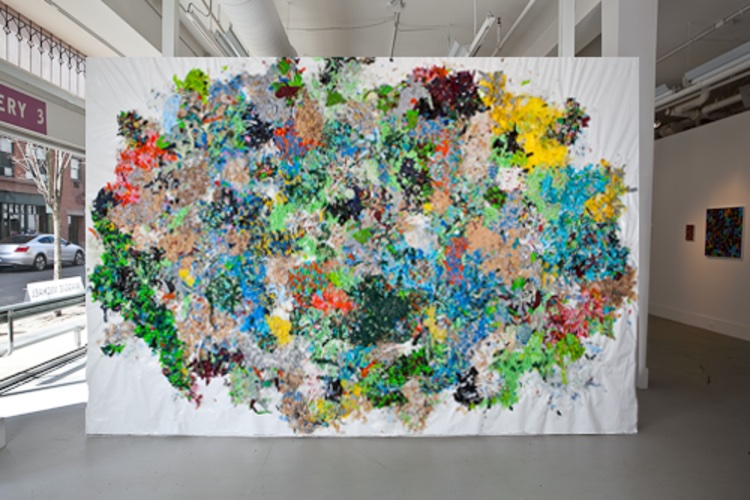Co-organized with independent curator Jessica Buckley
April 2 – June 20, 2009
Artspace, New Haven, CT
(Un)spoken is a group exhibition that explores the boundaries of collaboration and artistic production within the context of marital relationships. Working with curator Jessica Buckley, Artspace invited three artist-couples to create new works for the exhibition–which marks the first occasion that each of these artists has collaborated publicly with their partner on a work of art.
Instantly understandable and readable as one of society’s primary bonds, marriage can also be seen as a microcosm for how communities are built through ideas, effort, communication, and compromise. (Un)spoken delves into the nature of creative exchange, teamwork, and individuality that underscores these artists-couples relationships. And their works reveal how a confluence of forces can influence each artist’s perception of the production of their own work, as well as their partner’s.
Artists include: Karen Dow and Christopher Mir (CT); Linda Ganjian and Jesse Lambert (NY); Maggie Michael and Dan Steinhilber (Washington DC)
(Un)spoken exhibition catalogue: Unspoken_final_low

Karen Dow and Christopher Mir
Untitled, 2009
Acrylic on canvas
Courtesy of the artists
Photo: Kelly Jensen
As painters, artists Karen Dow and Christopher Mir live and work in Hamden, CT. Both Dow and Mir critique the role of mass production and historical narrative as forms of understanding and the impact of the built environment in our everyday experience. Dow creates geometric, abstract paintings that blend Mondrian’s plasticity of formal abstraction with elements of mapping and architectural design. She extracts color from our image-saturated, commercial environment to organize her canvases. Using found images culled from interior design magazines, photographs, postcards, and the Internet, Dow’s non-representational works probe the relationship between two- and three-dimensional space and the expressive capacity of color. Mir’s paintings present a world populated by mythic figures, creatures, machines, and fragments of ambiguous forms that are at odds with their surroundings. These elements are often positioned within idealized landscapes in dream-like circumstances. They are replete with complex narratives that explore provocative dichotomies such as the mystical versus the physical, the spiritual versus the secular, and the primal versus the futuristic. Mir’s use of bold saturated color and expressionistic brushwork underscore the chaotic feel of his work, which is alternately balanced by the quiet permanency that his figures exude.
Artists Linda Ganjian and Jesse Lambert live and work together in Brooklyn, NY. Both Ganjian and Lambert critique the roles of consumer and national messaging in providing a social framework for human relationships. In her drawings, sculptures, and installations, Ganjian employs the rich colors, geometric patterns, and intricacy of design characteristic of Persian art. She creates subtle, yet critical, commentaries on consumption, politics, and war. Her works frequently explore our relationship to our built environment and draw comparisons and contrasts between the historic and the modern-industrial architecture, eliciting tensions between past and present. Lambert is an abstract painter whose work blurs the boundaries between craft and industrial production, pattern and decoration, and unconscious and conscious mark making. Lambert borrows the bold, saturated colors, repetitive designs, and large-scale dimensions that characterize Pop Art. He pairs this historical narrative with forms and elements of the biological world, capturing how textures and rhythms found in nature are reproduced in our commercial environment.


Detail: Linda Ganjian
Avestan, 2007
Paper, acrylic, varnish, museum board and wood
Courtesy of the artist
Photo: Kelly Jensen
Maggie Michael and Dan Steinhilber live and work in Washington, DC. Both artists use the language of everyday materials to comment on the value of production and the aesthetics of everyday objects. Michael creates paintings that have a dialogue with the artistic creations and movements that preceded her. The organic forms that typically populate her compositions blur the boundaries between painting and sculpture, and are a synthesis of elemental forms exhibited in the works of Jessica Stockholder, Louise Bourgeois, Eva Hesse, and Barbara Hepworth. Using latex, acrylic, and enamel paints, Michael juxtaposes the synthetic with the organic, creating abstract works with a palpable dynamism and tension. Steinhilber is a sculptor who explores light, volume, and shape using everyday materials that range from plastic tubing to styrofoam cups. An artist influenced by the Process and Post-Minimal artists of the 1960s and ‘70s, Steinhilber stacks, scatters, leans, piles, and threads a variety of mass-consumables together. He creates objects and environments that comment on the aesthetic possibilities of industrially produced materials and the nature of urban architecture.

Maggie Michael and Dan Steinhilber
Untitled (Compass series), 2008-2009
Digital photograph on inkjet paper
Courtesy of the artists


